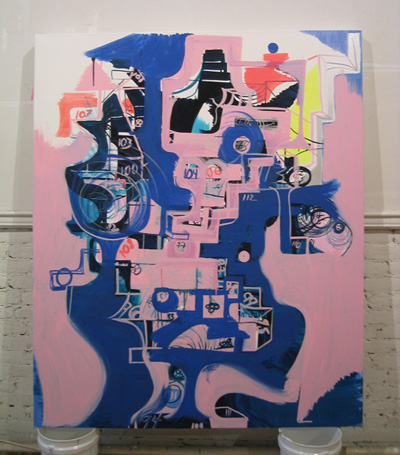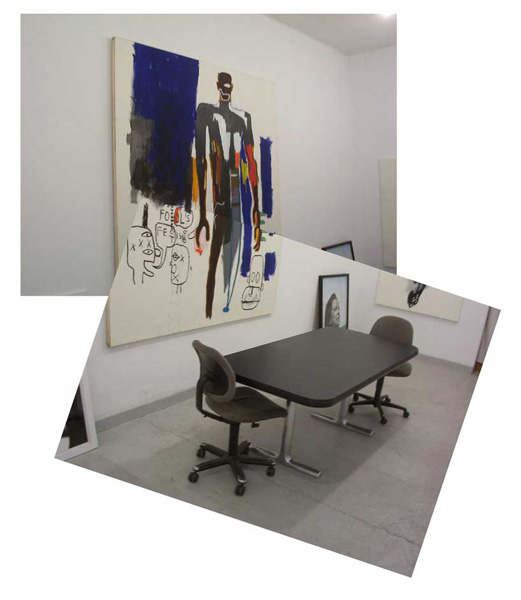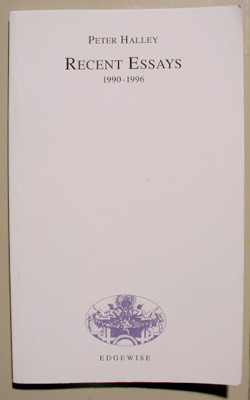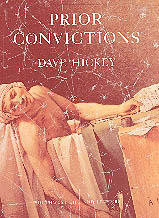May 24, 2005
Swimmer

1. Joanne Greenbaum sent me her latest and a hihowareya.
2. Then I see this relish from Chris Ashley, who is in New York this week (giving a talk at the Rhizome thingy):
BLOGPOST IN PROGRESS

I think about Basquiat's free street, graffitti, notational, additional, impulsive, canvas as a site for the world and the world itself.. how it broke ever so carefully the rigor mortis freezing the joints of composition, a blind eye to the anxieties of how a painting should look.... and remarkable too that it is in a looseness that he escapes the cavernous (like a grave digger) pigeonhole of anti-painting-painting/death of painting narratives... and therefore he would inspire painters of many later generations... (like Joanne?)
3. Chris was generous to post his gallery tour in NY, visiting Tony Scharazzi's Warhol show, pal of Basquait. Hit the Shafrazzi link and you 'll see a slide show of Basquait and Bacon... and late Picasso... awesome.

4. I have Aaron's gift of the Peter Halley book. Small and handy. I'm finding a few laudable aspects in it. Funny, though. There is a declaration of importance in its presentation that is undercut by the ruminatory nature of the writing.
This passage seems to stream along like a blog, this as he recounts how he met Andy Warhol:
Nevertheless, an invitation came, via Bruno, to visit with Warhol and get a tour of the Warhol studios, and that was something I just couldn't pass up. Actually, the Warhol people cancelled three times, but finally, in November '86, i did make it over to the last Factory for lunch.
I was really nervous. After all, it's completely strange to imagine meeting someone you'vethought of about every day for fifteen years. When I arrived, there was an array of people, including Bruno and Yuyo Bishofberger, Fred Hughs, and an Australian curator who seemed to be desperate for Factory-style attention, all sitting around an Art Deco-ish dining table, munching on pasta salad. But there was no Andy. After a while he shyly wandered in with a crumpled brown paper bag in which was a gift for Yoyo. He sat down but didn't eat. He just drank herbal tea.
It sure reads like a blog, doesn't it?
Less than an essay, even though it is titled "Recent Essays", a slim 63 pages -seemingly a concise distillation, maybe like the "Origin of the Species" or Newton's "De Analysi"... concise it is not. People in positions of authority write essays, make proclamations, pass laws... with concision.
Do the thoughts of Halley possess authority, as his paintings implicate systems of authority?
Pardon, whilst I meander on...
5. I remember it was Schafrazi who perpetrated a political statement by attempting to destroy Picasso's Guernica... or did he know that the layer of varnish would ultimately separate his spray paint from the strata of the great hand? (I imagine that there are a few artists who would arch their eyebrow at the appeltation... bah.)
Was the artiface behind the Schafrazi act as thin as dried varnish?
Now his gallery thunders.
6. It is worth mentioning that Chris Ashley's breadth of appreciation would include Basquait. With Chris' lush yet dematerialized HTML coded paintings, I think of him as a latter day Sol LeWitt. A lesser mind would be defending turf and pooping on anything different.
7. What bugs me is how the presentation of the Halley book portends authority while it is nearly a diary, more intimate than anything else. Why does the appearance of a figure of authority ring false to me? Enter, this article (for the first time in years do I link to the LATimes) about the apparent demsie of criticism:
But many newspaper and magazine critics pine for a golden age when giants walked the Earth: When the imposing Clement Greenberg was shaping modernism in painting, the biting H.L. Mencken was exhuming the reputation of Theodore Dreiser, and the impious Leslie Fiedler found unsettling Freudian meanings in the novels of Mark Twain.
They were giants in the past when freedom was more limited than it is today, and privilege was channelled through carefully tended and defended social structures. The Luddite's swan song: 'Where'd it all go?". All that is blowing up now, thank G-d.
The article quotes the great Dave Hickey:
Dave Hickey, an art critic best known for the book "Air Guitar: Essays on Art & Democracy," doesn't think the Internet is the problem. "But I do think that we're over," he says. "Being an art critic was one of those jobs like nighttime disk jockey or sewing machine repairman: It was a one- or two-generation job."For Hickey, art criticism lost its luster and excitement the same time art did. "There was a sense that things had a forward tilt," he says of American art after World War II, when it seemed to be moving toward a consummation. "Jackson Pollock changed the way the world looked, Andy Warhol changed the way the world looked."
But the high couldn't last forever, and the power went to the curators.
"I'm like Wolfman Jack," Hickey groans. "The times have passed me by."

I don't think he's worried too much. I think of him as primarily as a writer, a player on the field rather than a referee, especially after I read his "Prior Convictions", his swan song as a writer of fiction. He wrote that the tendency to cannibalize life for source material soured his experience in fiction. He likes the distance in art writing, and it is this distance that insulates him from the vanity of being declared the king of criticism.
Kings are quaint anyway.
8. I'm scratching an itch here.
Meade Arble told me two things: that there is a writer in me struggling to get out... and that this blog is a strategy for procrastination.
(!)
Maybe. I used to pace back and forth. Now I blog.
But I am already writing, so I don't have to become a writer, especially if one becomes one when one is published by a publisher. Movable Type is my publisher. And I've always swelled the pregnant pause before every painting. One of the worst aspects of Sam Francis' practice is that he never hesitated, never edited.
Although I can identify with the opening scenes in "Sideways". I too am a wretch.
Blogs are part of the story of the expansion of freedom in the 20th and 21st centuries. A big part, I'll bet.
Consider this:
-The MOCA Show "Public Offerings" declared that the only valid subject of art is the artworld as a system. The totalization of the system, an individual's experience is nowhere to be found.
-The art world system runs on prestige.
-Agents within the artworld have been interchanging roles and yet the overall structure has retained its overall form. Curators becoming educators for example (the recent article in X-tra, Ann Walsh's interview with Larry Rinder, (current issue, not online). More permutations exist, too many to list here. But the diminution of the role of the ciritic is the first signal of the change in the overall structure of the system.
-Prestige will flow differently in the future, ojal?, but it will flow.
9. I consider this blog as a part of my painting, a bibliographic entity. A historical resource. Better than that, a place to satisfy curiosity, to have fun doing it. It's the act of putting things together and sitting back and reflecting upon them.
Joe Marioni once asked me "...if people wanted to draw representationally, why not take a picture with a camera?" At the time, I responded: "Maybe there is something abstract in representation. We see with our brains, and through the eyes." But now I see that I have ported out much my my representational impulse out into this blog.
This blog is my sketchpad. The camera-plus-computer program, my pencil. It's going to get more vivid as technology evolves, it's going to be a lot of fun.
BLOGPOST IN PROGRESS
Leave a comment